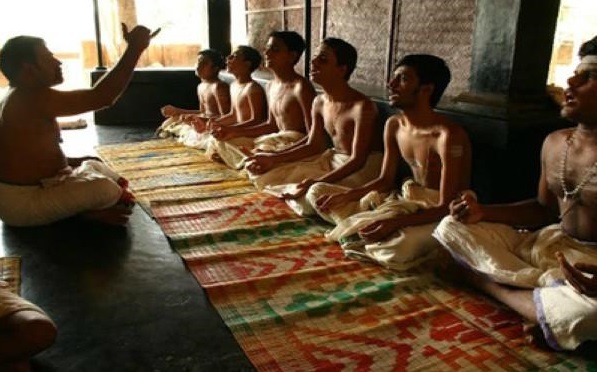Veda Adhyayanam

Lord Ganapathi is the primordial deity for Gaanapatyam. He is worshipped throughout India and by Jains & Buddhists too. He is present in all the temples and there are innumerable temples for worship of Ganapathi. He is the first to be worshipped before we do any puja. We even invoke Ganapathi in turmeric or even cow dung or clay idols on Vinayaka Chaturthi and worship him with Arugampil (Dhruva). Bhakti is more in Bhavana than in form.
His ears, head and trunk are in the form of “Om” kara with the chandrabindu on his forehead. His body represents the entire creation, which is manifestation of togetherness of Shiva & Shakti. The snake worn as a belt by Him, represents the Shakti, the power to hold the universe in an orderly manner. In his upper hands, he holds Angusam & Pasam, the former being a stick used to guide the elephant and the latter a rope used to tie it up. This is to mean that he shall guide the willing devotees and holds the ill-willed in troubles.
The Vedas are the roots of Hindu religion. All others, like feast and festivals, are like the leaves and fruits of that tree, depending for their sustenance on the Vedic roots. It is of no use feeling gratified that the Vedas have been written down, printed and published by Scholars. To us, Veda adhyayana and their employment in the sacraments of our daily life are important. For that purpose it is necessary to learn them by heart, understand their meaning, and recite them in the prescribed manner.
Word Adhyayanam means actually to know Veda & not to recite Veda. In olden days when there was no printing Veda was also recited. But knowledge of Veda was discussed & practiced. Veda itself means knowledge. Shastra says that mere recitation of Veda is worst without knowing knowledge. At present Vedas are published & computerized & so there is no need of mere recitation Vedas are believed to be the Divine revelations from the Cosmic Space recognized by Ancient Rishis. The Vedas known to humanity were much larger in content than it is actually known .
There as a Sage known as Vyasa, the legendary author of the Mahabharata Veda Vyāsa or Krishna Dvaipāyana (his original name) has classified the whole Vedas into four groups known as Samavedam, Yajurvedam, Rigveda and Atharvaveda. Sage Patanjali further divided these four into many branches or Shakhas. Rig Veda had twenty-one, Yajur Veda had one hundred and eight, Sama Veda had one thousand and Atharva Veda had nine shakhas. his Veda has been preserved for thousands of years through patasalas.
However, due to passage of time most of these have been lost to the present world. Of the remaining, one is of Rig Veda, Six are of Yajur Veda, Three are of Sama Veda and two are of Atharva Veda available now. It is already proven beyond doubt that Veda Mantras confer peace, prosperity and are for general well-being – Yogakhememam of the whole world. It is our duty to nourish and cherish the Vedas, which are the roots of our Culture and Sanatana Dharma for future generations.
However, in the past few decades, the Brahmanas who are supposed to do veda adhyayana, have not been following that Dharma. Paramacharya has emphasized that at least one child of a brahmana family must do Veda Adhyayanam to save this divine Veda for the future generations. Also, they have said that if we are not able to do Veda Adhyayanam, we need to support those who do the veda adhyayanam and veda patshalas.
Veda Adhyayanam was started in 1939. Now, the classes are conducted in the Main Hall of the temple and Sri Ganesha Sastrigal ensures continued attendance of children with his kindness and friendly attitude.
